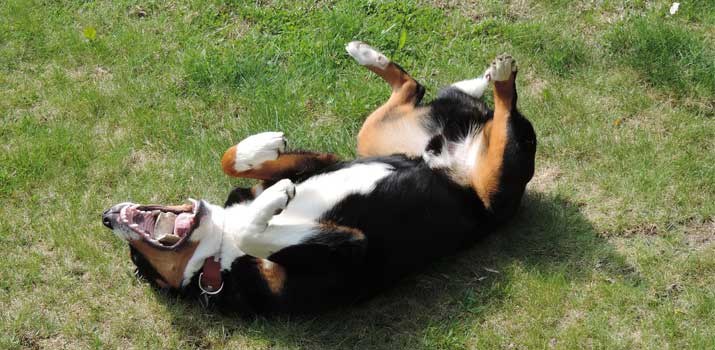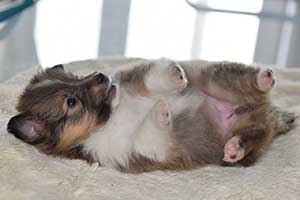All humans have one quirky mark that connects us to our time in the womb: The belly button! Whether yours collects link or protrudes visibly in a tight-fitting shirt, we all have one. It's the one thing holdover from the gestation period and forever connects us to our mothers.
Our belly buttons are so "under the radar" that most of us don't give it a second thought. That is, however, until we see one from a cute baby!
Believe it or not, belly buttons aren't just a sign of human gestation.

All mammals have them! It all comes down to the development and birth process. You won't see a belly button on any egg-laying animals. That includes egg-laying marsupials, which are technically mammals.
But wait! Does that include your dog? You've probably spent a fair amount of time dousing your furry friend in kisses and belly rubs. Surely, you would have noticed if they had a belly button like your own, right?
So, do dogs have belly buttons or not?
The Canine Belly Button
Canines do, in fact, have belly buttons! As a mammal, they have to! There's only one mammal that doesn't, and that's the aforementioned marsupials from earlier.
Your furry friend started his journey to life in a placenta, much like humans. As the tiny embryo develops into a full-fledged puppy, it resides in a fluid-fill sac and receives life-supporting nutrients from the placenta.
The placenta sends blood, nutrients, and oxygen through the umbilical cord, which connects to the puppy through the belly. It's a very similar process to what humans go through in the womb.
If you're lucky enough to see the magic of canine birth, a lot of those biological components are visible. They're usually referred to as the "afterbirth."
Puppies emerge from the womb with the placenta and umbilical cord still intact. Sometimes, the sac that carries them comes out, too. Though, it's usually torn during the birthing process.
After the puppy is born, the mother gets to work, freeing them from the confines of the womb. That means removing the umbilical cord and attached placenta. Mothers will typically chew through the cord, releasing the puppy to the world!
Also Read: The Reason Why Mothers (Sometimes) Eat Their Puppies
What Exactly is a Belly Button?
Contrary to popular belief, a belly button doesn't have to look like a button at all. This is probably why you have a hard time locating your dog's! More on that soon.
Technically speaking, the belly button is nothing more than a scar. It's the byproduct of the umbilical cord connection.
In dogs, some of the umbilical cord is left behind after the mother chews it off. However, the healing process starts immediately. With no more blood and nutrient supply, it has no purpose and can no longer sustain. So, it dries up and falls off in only a few days.
The Human Belly Button vs. the Canine Belly Button
There are some critical differences between human and canine belly buttons. Ultimately, those differences come down to the complexity of the umbilical cord.
In humans, it's a multifunctional transport system that supplies nutrients and gets rid of waste. It has a similar job in dogs, but the biological makeup is simpler.
It's smaller in size and diameter. As a result, the remaining scar is far less noticeable.
Where the cord is cut on a human umbilical cord determines whether or not you have a concave "innie" belly button or a protruding "outie." Leftover cord changes the way it heals, leaving more scar tissue that protrudes.
That's not the case with dog belly buttons. The simpler biological makeup of the umbilical cord creates similar scar tissue regardless. As a result, you're not going to have a concave indent or a protrusion. Instead, you'll see a flat scar!
What Do Dog Belly Buttons Look Like?
A healthy canine belly button appears flat and uniform. It's a bit more noticeable on a young puppy. But once it heals and they start developing hair, it's tough to spot!

Typically, the belly button will appear as a small mass of rougher skin. You can feel it to the touch. It's very similar to that of a traditional scar. In fact, the belly buttons on some dogs may appear stretched or linear instead of a central dog.
Over time, the area around the belly button will change, too. First, the hair follicles vary. Hair follicles act differently when they're in scar tissue rather than normal skin.
Generally, the direction of hair growth becomes circular. So, you might see a swirl of hair around the area.
In some dogs, the fur might be a little darker, too. This isn't always the case. But dogs with lighter fur tend to have a very subtle discrepancy in color.
Related: Do Male Dogs Have Nipples?
Where is Your Dog's Belly Button?
Now, onto the burning question: Where is it?
Exact locations can vary a bit. But, it's always below the rib cage and above the genitals. The belly button is close to the stomach. If you're looking around the ribcage, you're too far up! Use the aforementioned visual clues to narrow down your search.
Look for a whorl of swirly hair and a hint of darkness. If you see a unique texture, that's probably it! Use your fingers and feel for that roughness.
Most dogs pay no mind to their belly buttons. It's just another flat part of their bellies!
What If They Have an "Outie" Belly Button?
Like we mentioned earlier, "innie" and "outie" belly buttons are not possible for canines. On a healthy dog, belly buttons are flat scars. If it's anything but that, take a trip to the vet as soon as possible!
Growths that appear to be protruding belly buttons might be benign anomalies. Physical quirks and unique genetic scar formations are possible. However, it could also be a sign of something more nefarious.
Sudden protrusions could be a hernia. Hernias occur when organs poke through weak spots in the muscle lining the abdomen. The belly button is already vulnerable shortly after birth, so hernias are possible. In most cases, the offending organ is the intestines.
Some breeds, such as the Beagle and Pekingbese, are more susceptible to hernias than other breeds. Regardless, this isn't a health issue you can ignore. Take your pup to the vet for proper diagnosis and treatment.
Conclusion
Thanks to their flat nature, belly buttons usually don't pose any problems for dogs. Unlike human babies, there's no need to worry about anything getting stuck up there! It's just another physical quirk that calls back to their time in the womb.
If you've never seen your dog's belly button, check it out yourself! Chances are, your dog will be more than eager to get a belly rub and show you!

